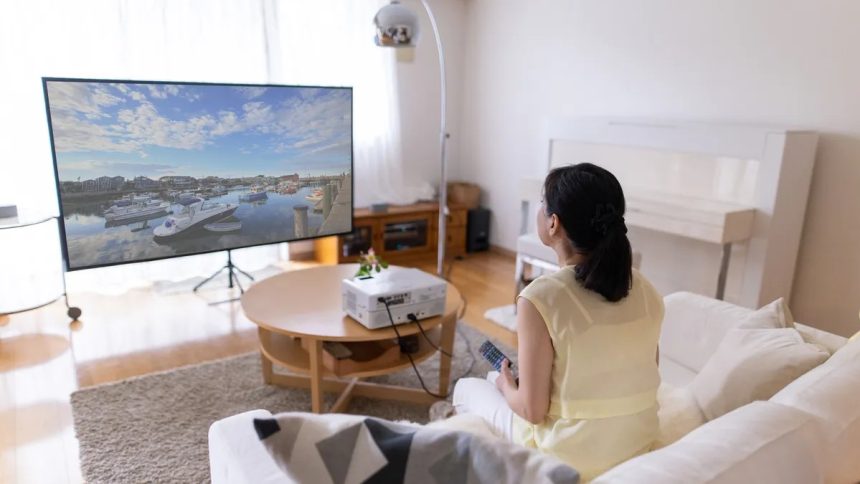Despite the declining prices of larger TVs, the biggest sizes can still be quite expensive. However, projectors have made significant advancements in picture quality and brightness in recent years. Nowadays, you can find projectors priced under $1,000 that outperform even high-end projectors from just a few years ago. These projectors are capable of producing stunning images exceeding 100 inches diagonally, far larger than what a typical “big” TV offers.
Projectors offer versatility and can be used for various purposes, including watching TV shows, movies, and gaming. Personally, I have relied on a projector as my primary “TV” for more than two decades. The experience of viewing larger-than-life images just a few feet away from your sofa is incredibly immersive. While setting up a projector may require a bit more effort than installing a TV, it is typically manageable without the need to hire a professional.
There are a few additional factors to consider when deciding whether to opt for a projector or not. Let’s explore them further.
Compare: Price vs. performance
When I first wrote about choosing a projector over a jumbo LCD TV 11 years ago, the TV and projector market was very different. Large TVs were prohibitively expensive, while projectors offered a cost-effective alternative with larger screen sizes. For the price of a 50-inch TV, you could get a projector and a screen that provided four times the screen real estate. The projectors of that time also boasted better contrast ratios and image quality compared to most TVs.
However, technology has evolved rapidly. Nowadays, you can find 75-inch TVs that have been awarded CNET Editors’ Choice for around $1,500, or even a 77-inch OLED TV for under $3,000. While these sizes may not match a 100-inch projection screen, they still offer a large, bright display and excel in HDR and wide color gamut capabilities. Furthermore, the advent of new technologies such as mini-LED and QD-OLED has further improved TV performance.
In summary, the price of large TVs has significantly decreased, while their performance has greatly improved, surpassing projectors at a much faster pace. Additionally, with good 4K projectors like the Sony VPL-VW325ES still being quite expensive, the overall picture quality of projectors often falls short compared to most TVs available today.
Contrast: TVs win for HDR
HDR poses a challenge for projectors due to their limitations in brightness and contrast ratio. While projectors can accept HDR video, they often struggle to display it effectively. The brightness of even the best home projectors is typically lower compared to the average television, which affects their ability to showcase HDR content. Additionally, many affordable projectors lack the necessary contrast ratio and wide color gamut capabilities to deliver optimal HDR performance.
Higher-end projectors can handle wide color gamut and HDR to a certain extent, but they come at a significantly higher price compared to large TVs. Despite advancements such as LED or laser light sources in some projectors, which offer improved color and brightness, their contrast ratios remain insufficient for satisfactory HDR reproduction.
While projectors can still produce impressive visuals without HDR, the absence of this feature is a notable limitation in the projector experience.
A little thing called light
One of the major practical challenges with projectors, unlike TVs, is the issue of ambient light. While projectors throw light at a screen, any other light in the room also affects the image quality. Bright parts of the image are less affected, but darker areas suffer more. This means that watching content with a lot of brightness, such as sports, is usually fine, but dark movies or video games can be difficult to see clearly.
Although there are screens designed to reject ambient light, they tend to be expensive and cannot completely overcome the impact of light in the room. Physics dictates that even the best ambient light-rejecting screen will still produce a subpar image compared to the same screen in a dark room. To achieve the best image quality with a projector in a room with lots of windows, extensive use of curtains is necessary.
In terms of brightness and performance in bright rooms, TVs outshine projectors. TVs create significantly brighter images and hold up better in well-lit environments. While this hasn’t convinced the author to switch to a TV, they acknowledge the need for blackout curtains in their own TV room, which may not be a sacrifice most people are willing to make.
Regrettably, for most people, TVs have become the superior choice over projectors. This statement holds more truth now than it did a few years ago. Unless one is willing to make compromises in their living environment, the slightly smaller screen of a TV is generally easier to live with. Moreover, TVs, especially OLED and high-performing LCD and QLED models, offer significantly better image quality, particularly with HDR.
While projectors continue to improve in terms of brightness, contrast, and color capabilities, their value proposition has shifted compared to TVs. Projector ownership now often entails sacrificing image quality, livability, and possibly price in favor of achieving the largest possible image. However, projectors remain an attractive option for those who desire even larger screens beyond 75 or 85 inches, until technologies like MicroLED become more affordable.
Please note that this information has been updated since its original publication on Dec. 17, 2021, with new details and references.
Geoff is a versatile writer and explorer who not only covers TV and display technology but also embarks on captivating photo tours of fascinating museums and locations worldwide. His adventures include visits to nuclear submarines, massive aircraft carriers, medieval castles, epic road trips spanning thousands of miles, and much more. If you’re interested in exploring these exciting places, be sure to check out Tech Treks, where Geoff shares his tours and adventures.
In addition to his expertise in technology and travel, Geoff is also an accomplished author. He has written a bestselling sci-fi novel centered around city-size submarines, and he followed it up with an equally compelling sequel. To stay updated on his latest escapades, you can follow Geoff on Instagram and subscribe to his YouTube channel, where he shares captivating visuals and stories from his explorations.








